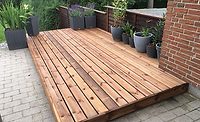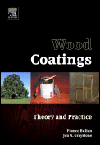Accelerated Weathering of Wood Coatings by QUV-A With Direct Water Spray

Accelerated weathering of coatings for wood by QUV-A with direct water spray closely approximates natural weathering by simulating the erosion and cleaning typical for exterior coated wood, increasing the moisture content of the wood above what is typically found in accelerated test procedures, and subjecting the coating to a much greater thermal shock than condensation methods. This paper examines the performance of various exterior wood coatings under this modified QUV test method.
Introduction
Coatings for exterior millwork such as exterior siding, decks and doors require distinct performance properties such as excellent light stability, high flexibility and freeze/thaw cycling properties. New waterborne (WB) UV-curing cosolvent-free polyurethane dispersions (PUDs) were developed to provide excellent exterior weathering properties, high flexibility, enhanced water resistance and improved adhesion to difficult substrates such as wood and plastic. This paper describes unique curing capabilities of WB UV PUDs, attributes and performance properties, and weathering results using an innovative accelerated weathering tester designed to simulate outdoor weathering of exterior wood coatings.
Radiation-Curing Dispersions
A broad variety of products have been commercialized in the wood coatings market over the last decade. The most promising environmentally friendly technology of these systems is waterborne UV-curing PUDs. The chemical structure of UV PUDs is quite similar to that of a regular PUD that consists of hard and soft segments (Figure 1). The broad raw material selection available for the design of each segment allows optimization of a huge variety of properties. In most cases, high-performance soft segments contribute a certain flexibility, while di(poly)isocyanates and short-chain diols contribute hardness and resistance. Several routes for the introduction of acrylic double bonds have been reported. In our experience, the best polymer performance can be obtained by introducing double bonds along the polyurethane chain, rather than attaching acrylic units to only the end of the chain or physically blending polyurethanes with acrylic monomers or oligomers. The use of acrylic monomers/oligomers may impart additional industrial hygiene issues and stability concerns.1-3Coatings based on PUDs exhibit excellent growth opportunities in the wood coatings market. The key property of this coating type is its similarity to conventional PUR coatings i.e., application methods, drying times and performance attributes.
UV-curing aqueous dispersions have a weight-average molecular weight above 200,000; this is many times higher than that of traditional 100% solids UV systems consisting of unsaturated acrylates and reactive thinners – a very striking advantage. That is why the waterborne systems need much less radical crosslinking to obtain the desired properties. This attribute opens up the possibility for a variety of traditional and unique curing methods. These high-molecular-weight polymers also reduce the hazards of skin irritancy associated with traditional low-molecular-weight acrylic oligomers.
UV Curing
UV radiation initiates coating cure in the presence of photoinitiators. It can be either by free-radical or cationic mechanisms. Numerous models and types of UV curing equipment are available from many suppliers. Typically the curing systems consist of a high-voltage power supply, a control panel and a curing head. Two types of lamps are typically used in UV curing i.e., regular arc lamp and microwave lamp. The spectral output of the lamps can be adjusted by doping the lamps with various trace metals. Each lamp has specific outputs measured in nanometer wavelength. The challenge of the formulator is to match the absorption of the photoinitiator to the spectral output of the lamp to cure the coatings, especially in highly filled/pigmented systems. The desired result is a highly crosslinked film that can meet several market standards. Additionally, UV coatings are environmentally friendly – most systems are typically solvent-free so emissions (VOC/VHAPs) and flammability are not a concern.
Waterborne UV-Curable PUDs for Exterior Coatings

- high productivity;
- outstanding weathering, even in clear;
- one component;
- high elasticity, even at low temperatures;
- excellent chemical resistance;
- tough and scratch resistant;
- various application methods;
- physical drying properties;
- high UV reactivity;
- fast water release;
- suitable for clear and pigmented coatings;
- very low VOC, environmentally friendly;
- reduced emissions; and
- safer to handle.

Weatherable Millwork Coatings
The term millwork is used to define a wide range of manufactured components for the construction industry. These components are used for both interior and exterior applications such as windows, doors and molding. Interior and exterior coatings can have a completely different set of property requirements based on their end use.For example, several high-end window manufacturers offer 10-year warranties on the durability of the finish on exterior windows. The topcoats used are generally very high-performance coatings, since they require very high weathering resistance, gloss retention and flexibility properties. Two-component (2K) polyurethanes are used because of their high-performance properties.
Environmental regulations are continually changing to reduce both plant emissions and VOCs of formulated coatings. These mandates can be enforced on a Federal, State, or even a local level. For example, the South Coast Air Quality Management District (SCAQMD) has mandated Rule 1136 for clear and pigmented sealers, topcoats and primers. The VOC limit will be reduced to 250 g/L. Table 3 illustrates several organization proposals.
Millwork manufacturers are demanding low-VOC, high-productivity and high-performance coatings from their paint suppliers. Wood coatings based on UV-PUDs can be formulated at less than 150 g/L and provide excellent application and performance properties.

Sunshine Curing Coatings
UV coatings are used predominantly in OEM factory applications that require very fast production speeds and superior performance properties. Recent work has been carried out to develop WB UV coating formulations that can be UV cured by natural sunlight. This technology is being explored for potential application in the DIY exterior wood coatings market. In addition to wood coatings, this technology may be applicable for other market areas such as exterior concrete coatings.The sun emits ultraviolet radiation in the UVA, UVB and UVC bands, but because of absorption in the atmosphere’s ozone layer, 98.7% of the ultraviolet radiation that reaches the Earth’s surface is UVA.5 Because of the high molecular weight of UV PUDs, it is possible to formulate coatings that both physically dry and photo-polymerize with direct UVA radiation from the sun. This is accomplished by using WB UV PUDs in combination with select photoinitiators that have distinct absorption peaks in the UVA range between 315-400 nm.
Sunshine curing coatings will definitely have their limitations, particularly the need for direct sunlight to photo-polymerize a coating film. Based on developmental screening performed in cloudy conditions in Pittsburgh, PA, the amount of direct sunlight required to develop surface hardness is surprisingly low.
Experiments were performed to evaluate both surface hardness and through hardness properties utilizing various curing methods. A formulation was prepared consisting of a UV-curable PUD, thermoplastic PUD, photoinitiators, and typical surfactants and defoamers used in water-based formulations. The volume solids of the formulation was about 24% solids and VOC at less than 1 lb/gal. The liquid coatings were applied to glass panels at 8 mils wet resulting in 1.5-2.0 mils dry (about 37 microns). Several glass panels were coated to evaluate the various curing methods as follows:
- high-intensity lamp emitting UVA, UVB and UVC (mercury lamp);
- low-intensity lamp emitting UVA only (4 minute exposure time);
- direct sunlight in Pittsburgh, PA (horizontal exposure); and
- dark room – no light.
Figure 2 shows coating film surface hardness properties using a pendulum hardness tester. Surprisingly, the surface hardness is very similar at 1 day, 3 days and 5 days for the various UV-curing methods, including sunshine cure. The dark room panel shows the dramatic effect on hardness from no UV exposure. The sunshine curing panel continues to increase in hardness considerably after 5 days, whereas the other UV-curing methods increase very slightly.

In addition to hardness properties, solvent resistance was evaluated, and the results showed very similar performance for the various UV-curing methods. The films placed in the dark room showed substantially lower solvent resistance compared to the UV-cured films.

Weathering Device

The method, specifications and time duration for the weathering study are as follows.
QUV-A Accelerated Weathering Tester - ASTM G-154-06, cycle 7
2000 hours total duration
Bulb type: UVA – 340 bulb
Irradiance: 1.55
Conditions:
8 h UV @ 60 °C
0.25 h water spray with no light and no temp. control
7 L/min of water during spray
3.75 h condensation @ 50 °C

Sunshine-Cured Coating Formulations
A project was designed and implemented to evaluate the weathering properties of various sunshine-cured WB UV wood coatings. The main objective was to test coating performance using a novel QUV designed for exterior wood coatings. Several formulation variations were made to evaluate the effects of UV absorbers (UV-As), hindered amine light scavengers (HALs) and/or binders.Test panels consisted of 3” x 12” pine substrates that were pretreated with a commercial wood preservative. Coatings were applied by brush and allowed to cure by direct sunlight for a minimum of 7 days before testing. The test coatings consisted of clear formulations only, with variations made to the UV-As, HALs and binders. Some blending and over coating of commercial white stains were also tested. The following coating systems were evaluated for each formulation:
- three coats of clear – self-sealed;
- one coat of commercial white stain followed by two coats of clear; and
- two coats of commercial white stain with 25% addition of clear coatings.
Table 4 gives an overview of the UV-curing clear coating systems that were tested.

Weathering Test Results
The five coating systems were evaluated at 500 hour intervals. Figure 6 shows the 60° % gloss retention of the clear coatings directly over pine wood substrates. As seen in Figure 6, the gloss retention of the various coatings differs significantly. The control system (A) without any UV-As or HALs showed the poorest gloss retention properties. Coating systems B and D demonstrated moderate gloss retention properties. Coating systems C and E, based on UV PUDs and select UVAs and HALs, exhibited excellent gloss retention properties.
Systems B, C and E provided excellent non-yellowing properties as indicated by the delta E results after 2000 hours exposure. The clear coatings were applied over a white stain to evaluate the actual yellowing of the clear coating and not the wood substrate. Systems A and D showed the worst overall performance, particularly poor bleed-through properties, as indicated in column four.
It should be noted that the rating for wood cracking in column 5 is based solely on the wood substrate and may not be a factor of the actual coating. A duplicate set of panels was sent to Florida to evaluate natural weathering for a period of 2 years. The performance results will be evaluated and reported every 3 months.
Conclusion
UV-curing aqueous dispersions have a very high molecular weight that enables film forming properties without UV and requires much less radical crosslinking to obtain the desired properties. This attribute opens up the possibilities for a variety of traditional and unique curing methods including sunshine curing.New waterborne UV-curing cosolvent-free PUDs provide excellent exterior weathering properties, high flexibility and improved adhesion to difficult substrates such as wood and plastic. Both clear and pigmented coatings are possible.
Formulations based on UV-curable PUDs are easily modified to meet various application methods such as conventional spray, airless spray, vacuum coating and roll-coating. Conventional waterborne additives can be used to improve surface wetting, defoaming, block resistance and surface appearance properties.
The incorporation of UV absorbers and light stabilizers are definitely recommended based on accelerated weathering testing. Different types of UV absorbers and/or light stabilizer showed variations in overall weathering performance properties and should be tested in the formulation.
Environmental regulations are continually changing to reduce both plant emissions and VOCs of formulated coatings. Coatings based on UV-curable PUDs can meet these new stringent environmental regulations.
This paper was presented at the RadTech UV/EB West show, Los Angeles, 2009.
Looking for a reprint of this article?
From high-res PDFs to custom plaques, order your copy today!







